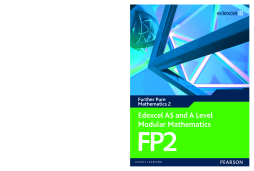
Additional Information
Book Details
Abstract
Edexcel and A Level Modular Mathematics FP2 features:
- Student-friendly worked examples and solutions, leading up to a wealth of practice questions.
- Sample exam papers for thorough exam preparation.
- Regular review sections consolidate learning.
- Opportunities for stretch and challenge presented throughout the course.
- ‘Escalator section’ to step up from GCSE.
PLUS Free LiveText CD-ROM, containing Solutionbank and Exam Café to support, motivate and inspire students to reach their potential for exam success.
- Solutionbank contains fully worked solutions with hints and tips for every question in the Student Books.
- Exam Café includes a revision planner and checklist as well as a fully worked examination-style paper with examiner commentary.
Table of Contents
| Section Title | Page | Action | Price |
|---|---|---|---|
| Cover | Cover | ||
| Contents | ii | ||
| About this book | iv | ||
| Chapter 1: Inequalities | 1 | ||
| 1.1: Solving inequalities by manipulation | 2 | ||
| 1.2: Solving inequalities graphically | 4 | ||
| Chapter 2: Series | 11 | ||
| 2.1: Using the method of differences to sum simple finite series | 12 | ||
| Chapter 3: Further complex numbers | 18 | ||
| 3.1: The modulus – argument form | 19 | ||
| 3.2: Euler’s relation | 20 | ||
| 3.3: Multiplying and dividing two complex numbers | 24 | ||
| 3.4: De Moivre’s theorem | 28 | ||
| 3.5: De Moivre’s theorem applied to trigonometric identities | 32 | ||
| 3.6: Using de Moivre’s theorem to find the nth roots of a complex number | 36 | ||
| 3.7: Using complex numbers to represent a locus of points on an Argand diagram | 40 | ||
| 3.8: Using complex numbers to represent regions on an Argand diagram | 51 | ||
| 3.9: Applying transformations that map points on the z-plane to points on the w-plane by applying a formula relating z = x + iy to w = u + iv | 53 | ||
| Review Exercise 1 | 66 | ||
| Chapter 4: First order differential equations | 72 | ||
| 4.1: Solving first order differential equations with separable variables and the formation of differential equations and sketching members of the family of solution curves | 73 | ||
| 4.2: Solving exact equations where one side is the exact derivative of a product and the other side can be integrated with respect to x | 77 | ||
| 4.3: Solving first order linear differential equations of the type dy/dx + Py = Q, where P and Q are functions of x, by multiplying through the equation by an integrating factor to produce an exact equation | 78 | ||
| 4.4: Using a given substitution to reduce a differential equation into one of the above types of equation, which you can then solve | 81 | ||
| Chapter 5: Second order differential equations | 87 | ||
| 5.1: Finding the general solution of the linear second order differential equation ad2y/dx2 + bdy/dx + cy = 0, where a, b and c are constants and where b2> 4ac | 88 | ||
| 5.2: Finding the general solution of the linear second order differential equation ad2y/dx2 + bdy/dx + cy = 0, where a, b and c are constants and where b2 = 4ac | 90 | ||
| 5.3: Finding the general solution of the linear second order differential equation ad2y/dx2 + bdy/dx + cy = 0, where a, b and c are constants and where b2<4ac | 91 | ||
| 5.4: Finding the general solution of the linear second order differential equation ad2y/dx2 + bdy/dx + cy = f(x), where a, b and c are constants, by using y = complementary function + particular integral | 93 | ||
| 5.5: Using boundary conditions, to find a specific solution of the linear second order differential equation ad2y/dx2 + bdy/dx + cy = f(x), where a, b and c are constants, or initial conditions to find a specific solution of the linear second order differential equation ad2x/dt2 + bdx/dt + cx = f(t), where a, b and c are constants | 97 | ||
| 5.6: Using a given substitution to transform a second order differential equation into one of the above types of equation, and solving it | 100 | ||
| Chapter 6: Maclaurin and Taylor series | 105 | ||
| 6.1: Finding and using higher derivatives of functions | 106 | ||
| 6.2: Expressing functions of x as an infinite series in ascending powers of x using Maclaurin’s expansion | 108 | ||
| 6.3: Finding the series expansions of composite functions using known Maclaurin’s expansions. | 112 | ||
| 6.4: Finding an approximation to a function of x close to x = a, where a ≠ 0, using Taylor’s expansion of the function | 115 | ||
| 6.5: Finding the solution, in the form of a series, to a differential equation using the Taylor series method | 118 | ||
| Chapter 7: Polar coordinates | 127 | ||
| 7.1: Polar and Cartesian coordinates | 128 | ||
| 7.2: Polar and Cartesian equations of curves | 130 | ||
| 7.3: Sketching polar equations | 132 | ||
| 7.4: Areas using polar coordinates | 136 | ||
| 7.5: Finding tangents parallel and perpendicular to the initial line | 139 | ||
| Review Exercise 2 | 145 | ||
| Examination style paper | 155 | ||
| Answers | 157 | ||
| Index | 185 |
